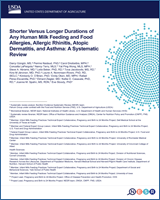| Evidence from birth to 24 months |
|---|
|
Kull 2002 (4)
Prospective cohort (BAMSE)
Sweden
|
N=3,791
Baseline: Birth
Race/ethnicity NR
| Partial BF ≥6 mo vs <6 mo | None | Suspected allergic rhinitis by 2 y: OR 0.80 (95% CI: 0.58, 1.09) |
| Evidence in childhood |
|---|
|
Codispoti 2010 (6)
Prospective cohort (CCAAPS)
US
|
N=80 African Americans, 218 non-African Americans
Baseline: Birth
Race/ethnicity: 22.2% African American, 77.8% non-African American
Risk: 100% family history (≥1 parent)
| BF duration (mo) | Allergic rhinitis at age 3 y in African American subsample: OR 0.8 (95% CI: 0.6, 0.9) | Allergic rhinitis at age 3 y in the non-African American subsample: OR 1.0 (95% CI: 0.96, 1.1) |
|
Kramer 2007 (5)
Cluster RCT3 (PROBIT)
Belarus
|
N=13,889
Baseline: Birth
Race/ethnicity NR
| Experimental group (higher rates of any BF measured at 3, 6, 9, and 12 mo) vs control group | None |
Ever had hay fever symptoms by 6.5 y: OR 1.1 (95% CI: 0.6, 1.9)
Hay fever symptoms in the past 12 mo at 6.5 y: OR 1.0 (95% CI: 0.6, 1.8)
|
|
Larsson 2008 (7)
Prospective cohort (DBH)
Sweden
|
N=4,779
Baseline: 1-4 y
Race/ethnicity NR
| BF duration <3 mo vs >6 mo | None |
5 year cumulative incidence of rhinitis by age 6-9 y: OR 0.96 (95% CI: 0.63, 1.46)
5 year cumulative incidence of any rhinitis symptoms by age 6-9 y: OR 0.80 (95% CI: 0.59, 1.07)
|
| | BF duration 3-6 mo vs >6 mo | None |
5 year cumulative incidence of rhinitis during by age 6-9 y: OR 0.94 (95% CI: 0.69, 1.29)
5 year cumulative incidence of any rhinitis symptoms during by age 6-9 y: OR 1.03 (95% CI: 0.84, 1.25)
|
|
Nwaru 2013 (9)
Prospective cohort (DIPP)
Finland
|
N=3,112
Baseline: Birth
Race/ethnicity NR
Risk: 100% high-risk genotype for T1D
| Total BF <5 mo vs >9.5 mo | None | Allergic rhinitis at 5 y: OR ~1.3 (95% CI: ~1.0, ~1.8) |
| | Total BF 5-9.5 mo vs >9.5 mo | None | Allergic rhinitis at 5 y: OR ~1.2 (95% CI: ~0.9, ~1.5) |
|
Sandini 2011 (10)
Prospective cohort4
Finland
|
N=891
Baseline: Birth
Race/ethnicity NR
Risk: 100% family history (≥1 parent)
| BF duration ≥2 mo vs <2 mo | None | Allergic rhinitis at 5 y: OR 1.87 (95% CI: 0.55, 6.36) |
|
von Kobyletzki 2012 (8)
Prospective cohort (DBH)
Sweden
|
N=3,124
Baseline: 1-2 y
Race/ethnicity NR
| BF ≤6 mo vs >6 mo | None | 5 y cumulative incidence of rhinitis by age 6-7 y: OR 1.02 (95%CI: 0.73, 1.43) |
